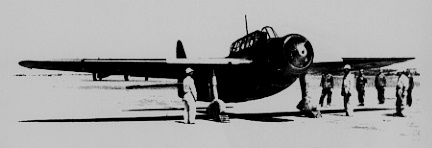|
Vice Admiral Matome Ugaki, Commander in Chief of the Fifth Air Fleet, wrote
in his diary the following about the situation at the time:
Friday, May 15, cloudy
The planes departed to attack the ships
around Okinawa, and among them were mixed some Shiragiku trainers. The enemy transmitted a message
saying that Japanese planes flying at 85 to 90 knots were following the
destroyers. The staff officers laughed, saying that the destroyers were
chasing the Japanese planes traveling at 80 or 90 knots.
The point has been
reached when we must assign training planes due to the shortage of planes for
use in special attack operations. In nighttime even a rabbit cannot win if it
meets an enemy night fighter. Therefore, training planes must be flown very
well to use them. The number of planes is sufficient, but great results are
not expected.
These are probably the true feelings of Commander Ugaki, who
ordered the body-crashing attacks. As even the Shiragiku trainers were
being
gathered together for special attacks, he thought, "The number of planes is sufficient, but great results are
not expected."
Believing in winning at any cost, he sacrificed our bodies, and these spirits
of the war dead who perished for our country are no longer here.
Petty Officer 1st Class Yukio Masuda of the
Kikusui Shiragiku Squadron departed from Kanoya
Air Base at 7:10 p.m. on May 27, 1945. He carried out a body-crashing attack
against the enemy fleet off Kadena and became a cornerstone in the
defense of the fatherland.
At
the beginning of May 1946 a white wooden box arrived at
the home of Miki Masuda, living in Miyakonojo City in Miyazaki Prefecture.
Nearly one year had passed already since her oldest son Yukio had died in
battle. No remains, no mementos, nothing was inside the box.
In August 1943, Yukio Masuda entered Naval Flight Training School upon
leaving the former Miyakonojo Middle School. After graduation from the Naval Flight
Training Program, he acquired skills in reconnaissance and communications and
transferred to Shanghai Air Base. In
September 1944, when he graduated from flight training, he was assigned to Kochi
Air Base and was called on to provide guidance as an instructor to those with
less experience.
At the beginning of March 1945,
the forces at Kochi Air Base were reorganized into operational units, and
special attack units were formed. Special attack training using the Shiragiku
trainers began. On
May 20, they advanced to Kanoya Air Base when ordered to participate in operations. The
Kikusui No. 1 Shiragiku Squadron, which received an order to sortie, lifted off
from Kanoya Air Base at midnight on May 27 and departed toward Okinawa skies
on an attack of no return.
Prior to his sortie, Yukio was allowed to return
home for a short time. They say that he showed a cheerful look to his mother
Miki as he said, "Surely I will attack and defeat the enemy. This may be
my final farewell." He was born on October 20, 1927, and at that time his age was 17
years, 7 months.
According to records at the Japanese Defense Agency's
Military History Archives, twenty
planes of the Kikusui No. 1 Shiragiku Squadron commanded by Lieutenant Junior
Grade Shigeru Kawada sortied on May 27 from 6:48 to 7:37 p.m. and carried out
body-crashing attacks. Their crews died for an eternal cause.
According to
investigations after the end of the war, they sunk the destroyer Drexler
and damaged nine ships including the Southard. Only 20 Shiragiku planes
of the Kikusui No. 1 Shiragiku Squadron sortied that night, so there is no
doubt about all their military achievements.
On June 25, 1945, Petty Officer 1st Class Shigeru Haruki, who belonged to the
Kikusui No. 3 Shiragiku Squadron, sortied from Kanoya Air Base and carried out a
body-crashing attack against the enemy fleet off Okinawa. After this final
sortie, the special attack operations toward Okinawa by the Shiragiku were
stopped.
The manner of the sortie of Petty Officer 1st Class Haruki, who
died an honorable death at the rear of the Shiragiku Special Attack Unit, was
as follows. Okinawa had already suffered an honorable defeat, so a feeling
spread at the bases that at that late hour special attacks should be
undertaken. All three planes that had sortied on the previous day (June 24)
were returning.
On June 25, the
Kikusui No. 3 Shiragiku Squadron planned sorties of five planes, including the
three from the prior day. Three planes departed between 7:00 and 7:30 p.m. However, that day also all of
the planes came back. The plane piloted by Haruki had
to turn back due to an oil leak. He encouraged the maintenance personnel to
speed up the repairs.
Haruki shook off the squad commander trying to dissuade
him with the following words, "It's
OK not to leave now! Wait for the next chance!" Haruki's plane took off
alone and left for the skies of Okinawa without any hesitation.
On June 26 at 12:18 a.m., there was a telegraphic
transmission from Haruki's plane, "I am now diving. Yuta,
yuta, yuta." This phrase meant "I will crash into a transport
ship." This farewell transmission was typed out by his observer, Petty Officer 2nd Class Takeshi
Iwashita, who was from the 13th class of the Ko Flight Training Program.
Petty Officer 1st Class Haruki was in the same 22nd squad as I was during
the Naval Flight Training Program, and he belonged to section 6, the one next
to mine. He had a strong sense of justice, and he also possessed a good sense
of responsibility. His behavior was always positive. When friction occurred between squads and units, he was a person who made his presence felt and
acted as mediator. It is not an accident that he left his name as the last
person in the Shiragiku Special Attack Unit to make a dive.
Crew Members - No. 1 Shiragiku
Squadron, Kikusui Unit
|
